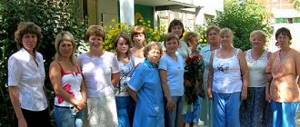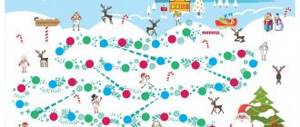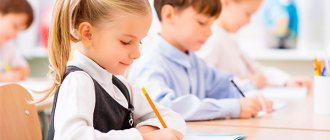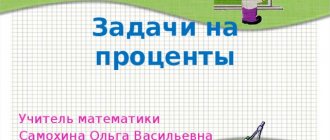“A creative workshop is one of the modern forms of working with children in preschool educational institutions.”
A creative workshop is one of the modern forms of working with children in preschool educational institutions.
1 slide
Dear colleagues, today I would like to introduce you to one of the modern forms of joint activity between a teacher and children - a creative workshop.
2slide
Creativity in the broad sense of the word is an activity aimed at obtaining something new, unique
3slide
A creative workshop is one of the forms of educational activity that allows children to show their initiative, as it provides an opportunity to satisfy their desires and needs in creativity.
The goal of working in a creative workshop is to preserve the child’s creativity; providing assistance in realizing its capabilities; promoting the development of independence and creative personality; development of cognitive interest of preschool children in the objective world.
4slide
The very concept of “workshop” came to pedagogy from the sphere of creativity, initially implying a place where something new is created, which did not exist until today.
The workshop is a conventionally designated group space with tables arranged into one common table so that the children and the teacher can sit together.
A workshop (into which a group room is temporarily transformed) is a specially organized space where beautiful, interesting and necessary things for a child’s life are purposefully created.
In kindergarten, there are several types of workshops depending on the composition of participants, goals and methods of activity, and the time duration of the process.
5slide
Workshops are divided according to the composition of participants:
- classes only for children;
- only for teachers
- only for parents (legal representatives)
- which can be carried out with both adults and children.
6slide
By goals and types of activities the following are distinguished:
— art workshop (includes appliqué, drawing, sculpting);
— theatrical (production of costume elements, invitation cards, posters, scenery);
— workshop of games and toys (furniture made from matchboxes, toys from boxes);
— souvenir workshop (making greeting cards, gifts for kindergarten employees, guests);
- architectural workshop (production of models of houses, roads, maps of the village, landscape models - mountains, volcanoes).
7slide
According to their duration, workshops are divided into “one-act” (during one lesson) and long-term (2-3 lessons), when the work is intermittent and can last a week (immersion method) or even for several weeks.
The use of a workshop is possible both as an independent unit, organized free of continuous educational activities, and as a form of organizing classes (or as part of it) when conducting a complex lesson.
Each workshop necessarily has a master teacher whose task is to include the child in the process of individual creative cognitive activity, help him make a discovery, and give him the joy of creating new, independently acquired knowledge.
8 slide
Work in a creative workshop can be carried out according to the following algorithm:
Motivation; discussion of what was seen; planning upcoming work together with children; distribution of responsibilities at the request of children if they work in pairs or in a microgroup; joint activities of the teacher and children; performance analysis
9slide
When organizing a workshop, a number of essential conditions must be observed. So N.A. Korotkova, I.A. Mukhin distinguishes the following conditions.
It is necessary to organize a common space for work. This can be a large work table (or several tables), made from ordinary tables moved together with the necessary materials, tools, samples.
These may be separate places for individual work.
Seats must be provided at the desk for all potential participants, including for the teacher, who does not separate himself from the children, but sits next to them. It is not recommended to strictly assign places for children, as in a lesson; here everyone can sit wherever they want, choosing their own neighbors from time to time. Children can move freely around the room if they need some kind of tool or material. The position of the teacher is also dynamic, who at each workshop is located next to one or another child who requires increased attention due to existing difficulties in this type of work or material and tools.
A common workspace organized in this way promotes a sense of freedom, provides the opportunity for each participant to see the actions of others, freely discuss goals, progress of work and results obtained, exchange opinions and discoveries “Look how mine is”, “I understand how it’s done!”
The second condition is the possibility of communication between workshop participants with each other, where dialogue (between workshop participants, individual groups, with oneself) is the main principle of interaction, cooperation, and co-creation in the course of work.
The next condition, according to N.A. Korotkova, the point is that when starting a lesson, an adult does not oblige or force them to do it, but draws their attention to the prepared materials and puts forward interesting ideas for work. In other words, the teacher offers children several goals (samples, diagrams) or different materials for the implementation of one goal in order to provide a choice based on interests and capabilities.
The teacher is involved in activities on an equal basis with the children - having chosen a goal for himself, he begins to act, becoming a living example of the systematic organization of work. He does not instruct or control the children (this is the style of the educational lesson), but discusses ideas, analyzes samples with them, and comments on the steps of his work; by his very active presence and desire to obtain the final result, he supports this desire among the other participants.
The atmosphere created when working in the workshop should contribute to the creative self-development of the child’s personality and stimulate him. “At the same time, it is important not only what we learn, but also what feelings and emotions we experience.” Therefore, the teacher is required to pay special attention to the state of the child’s emotional sphere.
An important condition in this situation is that the activity in the workshop should be non-evaluative, i.e. Critical remarks addressed to any workshop participant are unacceptable, which creates conditions of emotional comfort and creative freedom with the implementation of the principles of “pedagogy of success.”
As noted by N.A. Korotkov, the work offered to children should be designed by the teacher for 25-30 minutes, necessary to achieve the final goal (based on the pace of work of the “average” child of the group), and it is necessary to have some reserve of time so that everyone can, without rushing, get involved in the activity, deal with it at your own pace.
In this regard, another important condition when organizing a workshop is the fact that all activities have an open temporary end.
As they complete (achieve the goal accepted by each) children move on to free activities of their own choice. At this time, the adult does not leave the “work field” until everyone has completed their work, encouraging slow children with his presence.
Thus, children are offered work that involves the achievement of their own (personal) holistic product by each group member. The final products of all participants, without losing their independent value, can ultimately form a common product - a collection, a model, a large panel, etc. In other words, all members of the group can work together, side by side in a common semantic field, but each asserts himself in his own result. The result of work in the workshop is not only real knowledge or skill, but the process of comprehending the truth and the creation of a creative product are important.
And now we present to your attention a little experience in organizing a creative workshop in our group.
10-11 slide
The creative workshop began its work to prepare works for the exhibition of children's creativity “Winter Motifs”. A collective work “Winter Forest” was created. It turned out to be a wonderful landscape! The forest in them looks like a fairy tale, magic, the trees turned out slender, snow-covered, like lace.
11 words Individual works “Beautiful Christmas Tree” and “Snowman” were also created.” The guys united them with the common plot of “New Year’s Friends.”
12,13,14 slides
On the eve of the New Year holidays, the guests of our group were students from the Satis secondary school.
The meeting took place in the form of a creative workshop. Schoolchildren showed the children a theatrical fairy tale “Beasts in the Winter Forest”.
13 words Then the preschoolers and their guests went to a creative workshop, where they jointly created collective works using the “Bear in the Den” appliqué. The meeting was held on a positive note; the students, who were able to plunge into the world of preschool childhood and preschool children, received a lot of pleasant impressions from communicating with their older friends.
14 words At the end of the meeting, the schoolchildren presented their little friends with shovels made with their own hands in the school workshop.
15-16 slide
On the eve of Defender of the Fatherland Day, work began in the creative workshop on making gifts for dads.
16 words The children glued and decorated tea cups with the symbol of the country - the Russian flag. Individual works were also completed for a creative exhibition.
17-slide
Before the holiday “March 8 ” “Bouquets for Mothers” opened in our group . The children made a bouquet from their palms for their most beloved mothers. During the event, the children spoke touchingly and tenderly about their mothers; during a word game - “My mother is the most, the most,” the children found tender and affectionate words for their mothers. Everyone without exception took an active part in the workshop! They say that a child’s palms are little suns, they contain warmth, tenderness and love. This is doubly pleasant and valuable because the work is done in a team with other children.
18slide
The children prepared flowers for their beloved grandmothers. They are made by the hands of children, with a special feeling of warmth and love, and carry tenderness and love for close and dear people.
19-21 slide
For the Easter holiday, the Souvenir Workshop began its work, where crafts and souvenirs were prepared - “Chicken with an Easter egg”.
20 words The children made a chicken out of paper and decorated feathers with bright colors—a house for an Easter egg. Then the egg was painted with various patterns.
21 words Each child gave their loved ones a hand-made souvenir and evoked joy in anticipation of the bright Easter holiday.
22-26slide
22slide On the open day, a parent-child creative workshop opened in the group, which is one of the most effective forms of interaction between family and kindergarten. The parents and their children followed in the footsteps of the bunny and helped him change his white coat to a gray one.
23slide The main role in the creation and functioning of a parent-child creative workshop is played by the activities of the teacher.
Slide 24 With interested informal communication, parents’ anxiety disappears, a feeling of trust in the teacher and readiness to interact with him appears.
Slide 25 Parents and their child sculpt, draw, create something new and unusual. They become part of the child’s life, not the one where mom and dad worry about whether he has eaten? did you sleep? Did you dress warmly? And the one where the child is the little creator. Where did he come up with it himself? I did it myself! He is already an adult, they have common joys and questions.
Slide 26 And the work that the children and parents produce is worthy of all praise.
27slide
I would like to end my speech with the words of the great teacher Sukhomlinsky. He said:
“There is a bird sleeping inside every child that needs to be awakened to fly. Creativity is the name of this magical bird!”
The sooner a child awakens this bird within himself, the sooner he learns to see the beauty of the world around him, understand the language of nature, music, poetry, rejoice and be surprised, the brighter, more emotional, and purer he will be.
Project "Creative Workshop" project (senior group)
Senior group project
"Creative workshop".
Prepared and conducted by: Kuznetsova E.A.
Type of project: short-term from January 16-22.
Project participants: senior children, parents, teachers.
Relevance: Non-traditional techniques are an impetus for the development of imagination, creativity, the manifestation of independence, initiative, and expression of individuality. By using and combining different methods of depiction in one drawing, preschoolers learn to think and independently decide which technique to use to make this or that image expressive.
Goal: Development of children's creative abilities, imagination, imagination through non-traditional drawing.
Identification and development of creative abilities in older children through entertaining activities.
Tasks:
1.Introduce children to non-traditional drawing techniques.
2.Avoke emotional responsiveness in children.
3. Expand the possibilities of using non-traditional drawing techniques.
4.Form a sustainable interest in creative activities.
Working with parents:
— Consultation for parents “Unconventional drawing.”
— Bring cardboard tubes.
— Make salt dough for class.
| Educational area | Forms of organizing the activities of a teacher with children |
| Social and communicative development | Fix “Safety rules when working with scissors” Duty in a corner of nature: loosening the soil of indoor plants. Observation: trees in January. Reading a poem by A.A. Feta “As soon as the sun warms at noon, the linden tree in the heights blushes...” Role-playing game: “Artists” |
| Cognitive development | Video presentation D/i “Houses on the composition of numbers. Training apparatus". D/i “Find it in the picture.” Creative workshop: coloring with pencils. Salt dough mosaic. |
| Speech development | Conversation “Who are artists?” |
| Artistic and aesthetic development | Application “Rain of Hearts” Do-it-yourself volumetric paints. Crafts from cardboard tubes. Origami "House". Constructor made from paper circles. Drawing with semolina |
| Physical development | P/i "Fishing Rod". Difficulty: Players must perform jumps on one leg. Russian folk song "Wolf and Goat" Sports game badminton. Sports game hockey: game situation “International tournament”. |
Appendix No. 1.
Constructor made from paper circles.
Great idea and very simple. You can build amazing structures. Both simple and very complex. You can take this construction set with you on the road or invite your child to play in a cafe.
Appendix No. 2.
Volumetric paints.
Equipment:
- PVA glue,
- shaving foam,
- dye.
You just need to mix equal parts glue and foam. All that remains is to add dye (both powder and liquid are suitable) and achieve uniform coloring. The result is light, airy paints of the most delicate shades. After drying, the painting will become richer and retain its volume!
Appendix No. 3.
Crafts from cardboard tubes.
You don’t need much to come up with a new toy or make a simple craft with your child. Usually a little time and imagination is enough. There is a huge scope for creativity in crafts made from cardboard rolls. A kid can make a whole zoo or a racing car. The big advantage of such classes is ease and speed. The child will not have time to get tired of classes and will be able to quickly see the result of his work.
Appendix No. 4.
Salt dough mosaic.
The recipe for salt dough is traditional, but the application is unusual!
Dough: 1 cup salt, 1 cup water and 2 cups flour.
Divide the dough into pieces and add food coloring to each. Mix well until the color is uniform. Then roll out each piece into a thin layer. We divide the layers into small pieces of geometric shapes (circles, squares, triangles, rectangles, etc.) and bake them in the oven. Baking time: 30 minutes over low heat. The material for laying out bright and original mosaics is ready!



